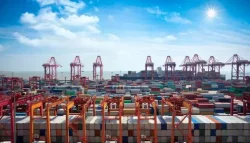2023-04-14
In March, U.S. imports showed signs of recovery. According to data released by Descartes on Tuesday, the volume of imported containers at US ports in March was 1,853,705 TEU, down 27.5% year-on-year, but up 6.9% from February and 4.2% from March 2019.
The ports of Los Angeles and Long Beach became the biggest winners, and the import volume of the twin ports increased by 30% and 25% respectively compared with February. Ports on the east coast experienced month-on-month declines, with the Port of Savannah down 6%, the Port of New York-New Jersey down 5%, and the Port of Charleston down 3%.
Cases From China Decline
Descartes data shows imports at Southern California ports are rebounding even as Chinese imports to the U.S. have fallen. Imports from China decreased by 46,573 TEU in March compared to February, which is equivalent to the total increase in imports from Thailand, South Korea and Japan.
In March, the volume of containers imported by the United States from China was 586,129 TEU, a decrease of 41.6% compared to the high point in August 2022. In February last year, imports from China accounted for 41.5% of U.S. import boxes, but by March this year, China's share had dropped to 31.6%.
The "Global Port Tracker Report" released by the National Retail Federation (NRF) and Hackett Associates counts the import box volume of 12 ports in the United States. The report estimated that imports at these ports would total 1.68 million TEU in March, up 8.3% from February.
NRF expects that US imports will continue to climb in the coming months, reaching 2.13 million TEU in August, an increase of 26.7% from March.
U.S. Goods Inventories to Draw Down
The risk to demand recovery, NRF predicts, is that it will take longer than expected to destock.
The U.S. Census Bureau released data on the wholesale inventories-to-sales ratio for February on Monday. Wholesale inventory of hardware, plumbing, and heating equipment was 2.47 times sales, 17% higher than before the epidemic in February 2019; the wholesale inventory-to-sales ratio of home appliances and electrical and electronic products was 1.37, lower than the 1.4 in November 2022 peak.
Has the supply chain returned to normal?
Port congestion has eased as imports have eased from their peak. The Global Supply Chain Stress Index released by the Federal Reserve Bank of New York showed that the supply chain has normalized, and the index fell below the historical average in March.
But there are other indicators that, while supply chains have improved significantly, they are not fully back to normal. Flexport’s weekly “Ocean Timeliness Indicator” (OTI) tracks the number of days it takes for a container to travel inland from the time it leaves its Asian factory until it leaves a U.S. port. Last week, the transpacific eastbound OTI was 65 days, down 42% from the January 2022 peak of 113 days, but still 40% above the 2019 average of 46.4 days. One of the reasons for the increase in OTI is more diversion of cargo entering from Eastern and Gulf Coast ports.
Multi-country post in Europe strengthens multiple terminal delivery modes




